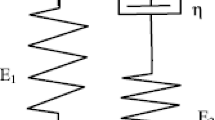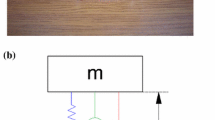Abstract
Analysis of the steady-state response of a polyurethane foam and masssystem to harmonic excitation is presented. The foam's uni-directionaldynamic behavior is modeled by using nonlinear stiffness, linearviscoelastic and velocity proportional damping components. Therelaxation kernel for the viscoelastic model is assumed to be a sum ofexponentials. The harmonic balance method is used to develop one- andtwo-term approximations to periodic solutions, and the equationsdeveloped are utilized for system identification. The identificationprocess is based on least-squares minimization of a sub-optimal costfunction that uses response data at various excitation frequencies andamplitudes. The effects of frequency range, spacing and amplitudes ofthe harmonic input on the results of the model parameter estimation arediscussed. The identification procedure is applied to measurements ofthe steady-state response of a base-excited foam-mass system. Estimatesof the system parameters at different levels of compression and inputamplitudes are thus determined. The choice of model-order and thefeasibility of describing the system behavior at several inputamplitudes with a single set of parameters are also addressed.
Similar content being viewed by others
References
Cunningham, A., Huygens, E., and Leenslag, J. W., ‘MDI comfort cushioning for automotive applications,’ in Proceedings of the Utech 1994 Conference, The Hague, The Netherlands, March 22–24, 1994, pp. 461–472.
Cavender, K. D. and Kinkelaar, M. R., ‘Real time dynamic comfort and performance factors of polyurethane foam in automotive seating’, Society of Automotive Engineers Technical Paper, Paper No. 960509, 1996.
Leenslag, J. W., Huygens, E., and Tan, A., ‘Recent advances in the development and characterization of automotive comfort seating foams’, in Proceedings of the Polyurethanes World Congress 1997, Amsterdam, September 29–October 1, 1997, pp. 436–446.
Moreland, J. C., Wilkes, G. L., and Turner, R. B., ‘Viscoelastic behavior of flexible slabstock polyurethane foams: Dependence on temperature and relative humidity. i. tensile and compression stress (load) relaxation’, Journal of Applied Polymer Science 52, 1994, 549–568.
Ferry, J. D., Viscoelastic Properties of Polymers, Wiley, New York, 1970.
Haddad, Y. M., Viscoelasticity of Engineering Materials, Chapman and Hall, 1995.
Hilyard, N. C., Lee, W. L., and Cunningham, A., ‘Energy dissipation in polyurethane cushion foams and its role in dynamic comfort’, in Proceedings of the Cellular Polymers, London, U.K., RAPRA Technology, 1991, pp. 187–191.
White, S. W., Kim, S. K., Bajaj, A. K., Davies, P., Showers, D. K., and Liedtke, P. E., ‘Experimental techniques and identification of nonlinear and viscoelastic properties of flexible polyurethane foam’, Nonlinear Dynamics 22, 2000, 281–313.
Singh, R., ‘Dynamic modeling of polyurethane foam and development of system identification methodologies’, M.S. Thesis, Purdue University, School of Mechanical Engineering, West Lafayette, IN, 2000.
Gibson, L. J. and Ashby, M. F., Cellular Solids. Structure and Properties, second edition, Cambridge University Press, Cambridge, U.K., 1997.
Horr, A. M. and Schmidt, L. C., ‘Modelling of nonlinear damping characteristics of a viscoelastic structural damper’, Engineering Structures 18(2), 1998, 154–161.
Muravyov, A., ‘Analytical solutions in the time domain for vibration problems of discrete viscoelastic systems’, Journal of Sound and Vibration 199(2), 1997, 337–348.
Dietrich, L., Lekszycki, T., and Turski, K., ‘Problems of identification of mechanical characteristics of viscoelastic composites’, Acta Mechanica 126, 1998, 153–167.
Muravyov, A. and Hutton, S. G., ‘Closed-form solutions and the eigenvalue problem for vibration of discrete viscoelastic systems’, Journal of Applied Mechanics 64, 1997, 684–691.
Gemant, A., ‘A method of analyzing experimental results obtained from elasto-viscous bodies’, Physics 7, 1936, 311–317.
Bagley, R. L. and Torvik, P. J., ‘Fractional calculus – A different approach to the analysis of viscoelastically damped structures’, AIAA Journal 21(5), 1983, 741–748.
Enelund, M. and Olsson, P., ‘Damping described by fading memory-analysis and application to fractional derivative models’, International Journal of Solids and Structures 36(7), 1999, 939–970.
Rusch, K. C., ‘Load-compression behavior of flexible foams’, Journal of Applied Polymer Science 13, 1969, 2297–2311.
Glockner, P. G. and Szyszkowski, W., ‘An engineering multiaxial constitutive model for nonlinear timedependent materials’, International Journal of Solids and Structures 26(1), 1990, 73–82.
Fosdick, R., Ketema, Y., and Yu, J. H., ‘Vibration damping through the use of materials with memory’, International Journal of Solids and Structures 35(5–6), 1998, 403–420.
Fosdick, R., Ketema, Y., and Yu, J. H., ‘A non-linear oscillator with history dependent force’, International Journal of Non-Linear Mechanics 33(3), 1998, 447–459.
Gandhi, F. and Chopra, I., ‘A time-domain non-linear viscoelastic damper model’, Smart Materials and Structures 5, 1996, 517–528.
Patten, W. N., Sha, S., and Mo, C., ‘A vibration model of open celled polyurethane foam automotive seat cushions’, Journal of Sound and Vibration 217(1), 1998, 145–161.
Singh, R., Davies, P., and Bajaj, A. K., ‘Estimation of the dynamical properties of polyurethane foam through use of Prony series’, Journal of Sound and Vibration 264(5), 2003, 1005–1043.
Nayfeh, A. H. and Mook, D. T., Nonlinear Oscillations, Wiley, New York, 1979.
Jordan, D. W. and Smith, P., Nonlinear Ordinary Differential Equations, Oxford University Press, Oxford, UK, 1987
White, S. W., ‘Dynamic modeling and measurement of occupied car seats and seating foam’, M.S. Thesis, Purdue University, School of Mechanical Engineering, West Lafayette, IN, 1998.
Doughty, T. A., Davies, P., and Bajaj, A. K., ‘A comparison of three techniques using steady state data to identify modal behavior of an externally excited cantilever beam’, Journal of Sound and Vibration 249(4), 2002, 785–813.
Author information
Authors and Affiliations
Rights and permissions
About this article
Cite this article
Singh, R., Davies, P. & Bajaj, A.K. Identification of Nonlinear and Viscoelastic Properties of Flexible Polyurethane Foam. Nonlinear Dynamics 34, 319–346 (2003). https://doi.org/10.1023/B:NODY.0000013511.07097.87
Issue Date:
DOI: https://doi.org/10.1023/B:NODY.0000013511.07097.87




